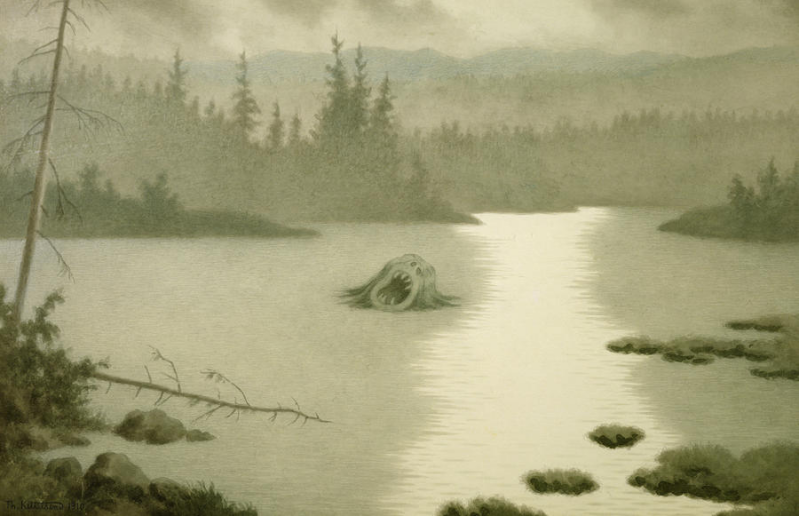GIANTS

“The Nøkk Screams” by Theodor Kittelsen (c. 1900)
The giants of the pre-Christian mythology and religion of the Norse and other Germanic peoples are a tribe of spiritual beings whose power equals that of the two tribes of gods, the Aesir and the Vanir. Their character, however, is very different from that of the gods – and, in fact, the giants and the gods correspond to opposing, but intertwined, cosmological principles.
The Devourers
“Giants” is a misleading Anglicization of the name of these beings. In modern English, of course, a “giant” is first and foremost something of enormous size. Calling a godlike being a “giant” can’t help but remind one of Michael Palin’s famous prayer in Monty Python and the Meaning of Life: “O God, you are so very big, and let me tell you, we’re all really impressed down here.” The word is a rather ludicrous designation for beings who were genuinely dreaded in heathen times.
Speakers of Old Norse called them jötnar (singular jötunn, pronounced roughly “YO-tun”) or þursar (singular þurs, pronounced “THURS” like the first element in “Thursday” but with a soft “s” at the end). Jötunn comes from the Proto-Germanic *etunaz and means “devourer.” The Old English eóten is a cognate (it means the same thing and comes from the same Proto-Germanic word).[1] Þurs is derived from the Proto-Germanic *þurisaz and means something like “powerful and injurious one” with a secondary connotation of “thorn-like.” The Old English ðyrs and Old High German duris are cognates.[2]
How, then, did these “devourers” come to be called “giants?” When the Norman (French) William the Conquerer seized control of England in 1066 CE, the English language became filled with French words. Among these loanwords was the Old French geant, the ancestor of the modern English word “giant,” which replaced the Old English eóten. Geant referred to the Giants of Greek mythology, who were a group of spiritual beings who, like the jötnar of Germanic mythology, were the enemies of the gods. The Greek ancestor of geant, in turn, was once used to translate a Hebrew word that denoted beings of enormous size in the Bible, and over time this connotation of “giant” became the word’s dominant meaning.[3]
Now that we’ve addressed these important linguistic considerations, we’re in a much better position for exploring who these “devourers,” as we’ll now call them, are, and what their role is in the pre-Christian Germanic worldview.
Utangard Spirits
One of the fundamental concepts that underlies the indigenous Germanic worldview is the distinction between the innangard and the utangard. “Innangard” means “within the enclosure” and refers to that which is orderly, law-abiding, and civilized. “Utangard” means “beyond the enclosure” and refers to that which is chaotic and anarchic. Asgard, literally “the enclosure of the Aesir gods,” is the divine model of the innangard. Midgard, the world of human civilization, is patterned on Asgard and allied with it.
The world of the devourers is Jotunheim, “the world of the jötnar,” which is also called Utgard (Old Norse Útgarðr). “Utgard” means the exact same thing as “utangard” (once again, “beyond the enclosure”).
Thus we see that the Aesir are the innangard beings par excellence, while the devourers are the utangard beings par excellence.
This typology is borne out throughout the sources, where the Aesir are the benefactors and protectors of civilization, while the devourers are constantly trying to drag it back to primordial chaos (and, at Ragnarok, they succeed). They’re forces of destruction, entropy, and decay.
Nevertheless, the devourers weren’t straightforwardly evil; at times, they could also play constructive roles (albeit usually inadvertently).
This is shown most clearly in the Norse creation narrative, wherein the gods construct the cosmos out of the corpse of the slain devourer Ymir. Here, as elsewhere in the sources, we find a recognition of the basic ecological understanding that civilization doesn’t exist in a vacuum, and its sustenance depends on the existence of chaotic and wild realms which contain the resources it requires for its continued existence.[4] The gods themselves are almost all descended from devourers; for example, Odin is half devourer, and Thor is three-quarters devourer. The gods don’t seek to annihilate the devourers, but rather seek to keep them in check so that the cosmos remains in balance. This mitigation and partial control also seems to have been the goal of the worship or propitiation of the devourers during the Viking Age.[5]
Thus, while attempts were made to keep the devourers at bay, their value was also recognized. Paradoxically, these forces of entropy are also necessary for the flourishing, and even the very existence, of the cosmos.
References:
[1] Orel, Vladimir. 2003. A Handbook of Germanic Etymology. p. 86.
[2] Ibid. p. 429-430. For the “thorn-like” connotation, consider the list of þur- words denoting “thorn” or “thorny,” as well as the Thurisaz rune, which is a pictograph of a thorn and was even called “thorn” in later Germanic alphabets.
[3] “Giant” in the Online Etymology Dictionary. http://www.etymonline.com/index.php?term=giant&allowed_in_frame=0
[4] Kure, Henning. 2003. In the Beginning Was the Scream: Conceptual Thought in the Old Norse Myth of Creation. In Scandinavia and Christian Europe in the Middle Ages: Papers of the 12th International Saga Conference. Edited by Rudolf Simek and Judith Meurer. p. 311-319.
[5] Steinsland, Gro. 1987. Giants as Recipients of Cult in the Viking Age? In Words and Objects: Towards a Dialogue Between Archaeology and History of Religion. Edited by Gro Steinsland. p. 212-222.


Create Your Own Website With Webador